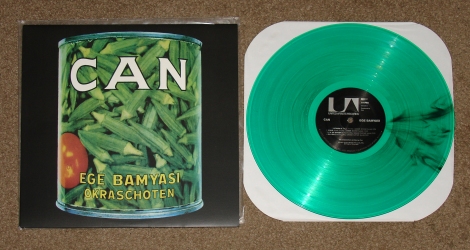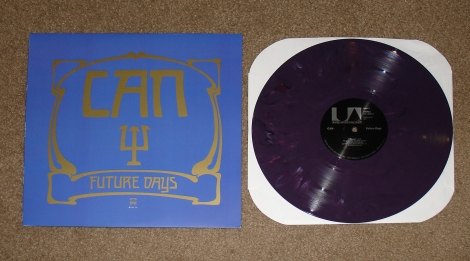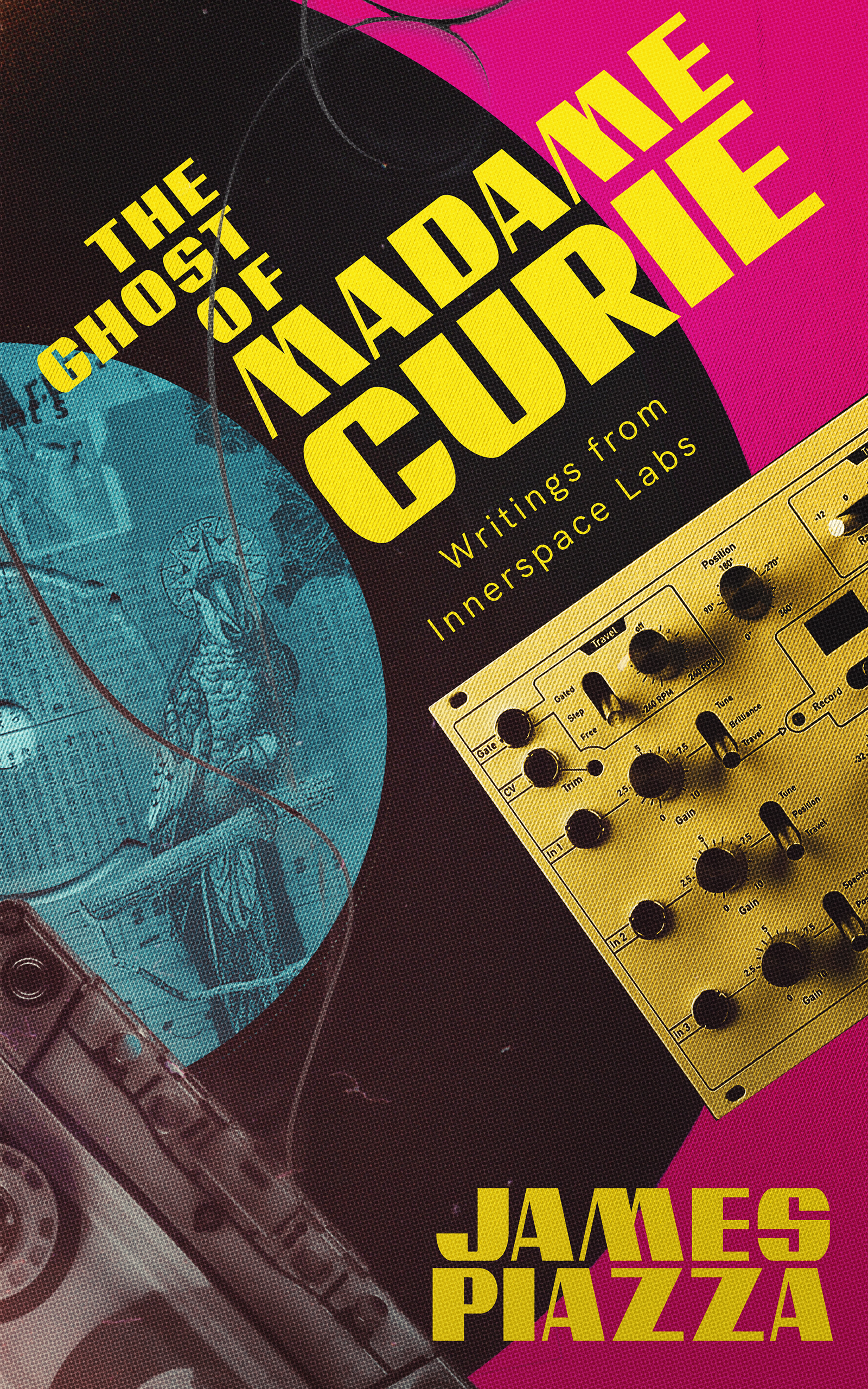Welcome to the conclusion to my 2-part feature on kosmische essentials. First, an apology to readers who expected to see Neu’s first two albums, La Dusseldorf, Faust, and Harmonia. I fully recognize the importance and grand influence of these artists, however they’ve thus far been absent from my collection. They will surely be added in due time, but for now we’ll begin with another essential – Germany’s Can.
Can recorded three milestones of krautrock between 1971 and 73 – namely, Tago Mago, Ege Bamyasi, and my favorite – Future Days. Fans may argue that their debut album Monster Movie was a far more important record, but these three albums feature some of the most mind-blowing tracks I’ve ever heard. This is effectively the opposite of Kraftwerk. Instead of Ralf and Florian’s polished industrial mechanized music, Can offers chaotic, psychedelic tunes and spontaneous lyricism that made them icons of the genre.
These are the United Artists marbled vinyl pressings from around 2009. I’m uncertain whether or not these are authorized reissues, but no corners were cut on the quality of either the heavyweight gatefold jackets or the quality of the colored vinyl. Absolutely essential.

Can – Tago Mago (1971)
Can – Ege Bamyasi (1972)
Popol Vuh is another artist with a dauntingly extensive catalog of albums. I’ll highlight my personal favorite – Hosianna Mantra – minimal choral music from Germany recently reissued by a small independent record store in Spain. The pressing restored the original album art (after the 1980s American issue replaced the gorgeous cover with a boring large yellow circle). Better still, the disc shipped with a bonus 7″ single and a poster, limited to 500 copies worldwide. Wah Wah Records continues to release long out-of-print titles and is a label well-worth exploring.
Popol Vuh – Hosianna Mantra (1972)
Another essential deep into the territory of Berlin School ambience is Manuel Gottsching’s Inventions for Electric Guitar from 1975. This, in my humble opinion, is space rock perfection. An expert’s blend of guitar, trance inducing rhythm, and delay and echo effects. There’s really very little else happening on this record, but Gottsching transports the listener to the furthest reaches of outer space. This is music for interstellar travel.
Manuel Göttsching – Inventions for Electric Guitar (1975)
And Inventions became the precursor to Gottsching’s most important work – E2-E4 from 1984. Allmusic was spot-on when they described the record as sounding like the house music of the 20 years that followed its release. Gottsching focuses all his energy on the delicate interplay between guitar loops, drum synths, and sparsely-interjected tones from an accompanying synthesizer. This is pure trance… from 1984.

Manuel Göttsching – E2-E4 (1984)
But perhaps no individual had as expansive a solo and collaborative catalog in the Berlin School than Klaus Schulze. Irrlicht (1972) was Schulze’s first official solo album, recorded just a month before Zeit. This is cerebral, classically-influenced cosmic music – a magnificent milestone of the genre.
Klaus Schulze – Irrlicht (1972)
If you buy only one Klaus Schulze record, (and there are well over 100), please consider the massively successful double LP – X from 1978. X is hypnotic and entrancing modern classical music and is universally acclaimed as one of Schulze’s finest efforts. The album is subtitled, “Six Musical Biographies” as each track is named after one of Schulze’s greatest inspirations. This is not passive listening – these songs, many in excess of 20 minutes in length, are engaging explorations of synthesized sound.
Klaus Schulze – X (1978)
Also recommended are Schulze’s 12-volume collaboration with Pete Namlook – The Dark Side of the Moog series, and for the fan who has everything-Schulze, I encourage you to look into The Ultimate Edition – a 50-disc collection of box sets featuring numerous live and non-album recordings. It clocks in at 65 hours of material and I love cuing it up at work to transform my 9-5 into a calm and meditative atmosphere.
Here I’d like to touch quickly upon a non-German record that was really in the spirit of what Schulze and his fellow Berlin-schoolers were up to in the late 70s. Steve Hillage, one of the primary figures of the Canterbury scene in the UK recorded Rainbow Dome Musick for the Festival for Mind-Body-Spirit in 1979. While not geographically qualifying as “Berlin School,” it is most definitely of the same caliber as its German counterparts.
The album features Hillage on guitars, the Fender Rhodes, and ARP and Moog synthesizers. A smattering of Tibetan bells and the sound of a running stream make the album approach the then-budding territory of New Age music, but Hillage’s musicianship and penchant for the avant-garde exempt the album from the flood of forgettable New Age music of the era. If you like Schulze’s solo work, you really should check out Rainbow Dome Musick.
Steve Hillage – Rainbow Dome Musick (1979)
I always end my multi-album features with something unique – and this is no exception.
Public Service Broadcasting is a London-based duo who create retro-futuristic electronic music much in the spirit of classic krautrock. They use samples from old public information films, archival footage and propaganda material, to (quote) ‘teach the lessons of the past through the music of the future’. PSB combines classic synths with banjo, ukulele, sax and trumpets all propelled by a nearly-motorik beat.
Both their album art and their music bear the streamlined magnificence of the Futurists. My two favorite selections are The War Room EP and their first full-length release, Inform, Educate, Entertain. I’ve also just pre-ordered their exciting new record scheduled for release this February.
Public Service Broadcasting – Inform Educate Entertain
But to close with a proper German record, I can’t leave out my recent acquisition from December of 2014 – GAS. Wolfgang Voigt’s legendary titles released under the Gas moniker were combined in an abbreviated double LP, Nah Und Fern in 2008 on the Kompakt label. Recorded between 1996 and 2000, Gas is perhaps the ultimate vision of the Berlin School’s musical philosophy. To recap the brilliant descriptions from critics upon its release – zero-gravity club music, tunes for lucid dreaming, underwater techno, or as Wire put it, “an outdoor rave, heard floating through the air from a neighbouring village.” This is precisely the sound of Gas.
Gas – Zauberberg (1997)
Gas – Königsforst (1999)
Gas – Pop (2000)
My next German music purchases will likely include the first Cosmic Jokers LP, Schulze’s Timewind, and Froese’s solo debut – Aqua on the Brain label.
I hope these featured essentials are helpful to anyone venturing into kosmische music for the first time. Have I left out any of your own favorites? Let me know!






























Leave a comment